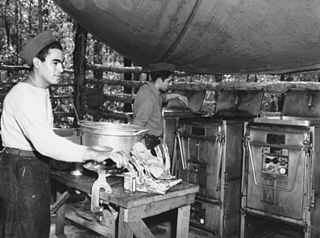
The Meal, Ready-to-Eat (MRE) is a self-contained individual United States military ration used by the United States Armed Forces and Department of Defense. It is intended for use by American service members in combat or field conditions where other food is not available. MREs have also been distributed to civilians as humanitarian daily rations during natural disasters and wars.

The C-ration was a United States military ration consisting of prepared, canned wet foods. They were intended to be served when fresh or packaged unprepared food was unavailable, and survival rations were insufficient. It was replaced by the similar Meal, Combat, Individual (MCI) in 1958; its modern successor is the Meal, Ready-to-Eat (MRE).
The Combat Capabilities Development Command Soldier Center, formerly the United States Army Natick Soldier Research, Development and Engineering Center, is a military research complex and installation in Natick, Massachusetts, charged by the U.S. Department of Defense with the research and development of food, clothing, shelters, airdrop systems, and other servicemember support items for the U.S. military. It is a component unit of the United States Army Combat Capabilities Development Command and is a tenant unit of the United States Army Natick Soldier Systems Center (SSC). The installation includes facilities from all the military services, not just the Army, and is so configured to allow cross-service cooperation and collaboration both within the facility and with the many academic, industrial and governmental institutions in the Greater Boston Area.

Gastronomy is the study of the relationship between food and culture, the art of preparing and serving rich or delicate and appetizing food, the cooking styles of particular regions, and the science of good eating. One who is well versed in gastronomy is called a gastronome, while a gastronomist is one who unites theory and practice in the study of gastronomy. Practical gastronomy is associated with the practice and study of the preparation, production, and service of the various foods and beverages, from countries around the world. Theoretical gastronomy supports practical gastronomy. It is related with a system and process approach, focused on recipes, techniques and cookery books. Food gastronomy is connected with food and beverages and their genesis. Technical gastronomy underpins practical gastronomy, introducing a rigorous approach to evaluation of gastronomic topics.

United States military ration refers to the military rations provided to sustain United States Armed Forces service members, including field rations and garrison rations, and the military nutrition research conducted in relation to military food. U.S. military rations are often made for quick distribution, preparation, and eating in the field and tend to have long storage times in adverse conditions due to being thickly packaged or shelf-stable.

The Air Education and Training Command (AETC) is one of the nine Major Commands (MAJCOM) of the United States Air Force (USAF), reporting to Headquarters, United States Air Force. It was established 1 July 1993, with the realignment of Air Training Command and Air University.

Orange chicken is an American Chinese dish of fried chicken in a sweet orange-flavored chili sauce glaze.

The United States Army Training and Doctrine Command (TRADOC) is a major command of the United States Army headquartered at Fort Eustis, Virginia. It is charged with overseeing training of Army forces and the development of operational doctrine. TRADOC operates 37 schools and centers at 27 different locations. TRADOC schools conduct 1,304 courses and 108 language courses. The 1,304 courses include 516,000 seats for 443,231 soldiers; 36,145 other-service personnel; 8,314 international soldiers; and 28,310 civilians.

The United States Army Quartermaster Corps, formerly the Quartermaster Department, is a sustainment and former combat service support (CSS) branch of the United States Army. It is also one of three U.S. Army logistics branches, the others being the Transportation Corps and the Ordnance Corps.

The U.S. Army Combined Arms Support Command (CASCOM) is a major subordinate command of the U.S. Army Training and Doctrine Command (TRADOC) and is located at Fort Gregg-Adams, Virginia. Subordinate to CASCOM is the Sustainment Center of Excellence (SCoE), which oversees and coordinates the five sustainment branches of the Army and the Army Sustainment University. The commander of CASCOM is dual-hatted as the head of SCoE. The CASCOM commander also serves as the commander of Fort Gregg-Adams.

The Armed Forces Institute of Pathology (AFIP) was a U.S. government institution concerned with diagnostic consultation, education, and research in the medical specialty of pathology.

Foods of the American Civil War were the provisions during the American Civil War with which both the Union and Confederate armies struggled to keep their soldiers provisioned adequately.

The Doriot Climatic Chambers (DCCs) are a pair of very large, highly specialized wind tunnels/environmental chambers located at the U.S. Army’s Soldier Systems Center (SSC) in Natick, Massachusetts. Built in 1952, the Chambers are a unique facility, capable of simulating an extreme range of global weather conditions for the testing of both the physical properties of military equipment and the physiology and adaptations of human subjects.

The B-ration was a United States military ration consisting of packaged and preserved food intended to be prepared in field kitchens by cooks. Its modern successor is the Unitized Group Ration – M (UGR-M), which combines multiple types of rations, including the B-ration, under one unified system.

The Quartermaster General of the United States Army is a general officer who is responsible for the Quartermaster Corps, the Quartermaster branch of the U.S. Army. The Quartermaster General does not command Quartermaster units, but is primarily focused on training, doctrine and professional development of Quartermaster soldiers. The Quartermaster General also serves as the Commanding General, U.S. Army Quartermaster Center and School, Fort Gregg-Adams, Virginia and the traditional Quartermaster Corps.
Foodista.com is an online recipe, cooking, and food news source. Foodista is built by both registered community members and anonymous contributors through a structured wiki. With all content available under a Creative Commons Attribution 3.0 license, the site contains articles on recipes, foods, cooking tools, techniques, and food news.

Mortuary Affairs is a service within the United States Army Quartermaster Corps tasked with the recovery, identification, transportation, and preparation for burial of deceased American and American-allied military personnel. The human remains of enemy or non-friendly persons, are collected and returned to their respective governments or affiliations.

The U.S. Army Sustainment Center of Excellence (SCoE) [pronounced sko or sko-e] is a subordinate organization under the U.S. Army Combined Arms Support Command (CASCOM) at Fort Gregg-Adams, Virginia. Its mission is to oversee and coordinate the functions of the 5 sustainment branches of the Army and the Army Sustainment University. The CASCOM commander is dual-hatted as the commander of SCoE.

The history of military nutrition in the United States can be roughly divided into seven historical eras, from the founding of the country to the present day, based on advances in food research technology and methodologies for the improvement of the overall health and nutritional status of U.S. military service members. Through the research and guidance of medical and military professionals, rations and packaging have been consistently and dramatically improved.

The Unitized Group Ration (UGR) is a United States military ration used by the United States Armed Forces and Department of Defense (DoD). It is intended to sustain groups of American service members with access to a field kitchen, serving as a field ration and a garrison ration. It is the modern successor to several older alphabetized rations—namely the A-ration, B-ration, and T-ration—combining them under a single unified system. UGRs are designed to meet the Military Daily Recommended Allowance when averaged over a 5 to 10 day period, with each meal providing between 1,300 and 1,450 kcal.

















